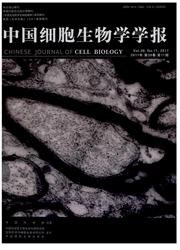

 中文摘要:
中文摘要:
采用Westernblot、免疫荧光和PcR检测小鼠单核巨噬细胞系RAW264.7中S1P受体1-3(SIPR1-3)的表达,然后应用吞噬实验和免疫荧光的方法检测磷酸鞘胺醇(sphingosine1-phosphate,S1P)对其吞噬功能的调节。分别应用药理学工具和小干扰RNA的方法研究SIP调节其吞噬活性的作用机制。结果显示,小鼠单核巨噬细胞系脚264.7表达S1PR1-3;SIP剂量依赖地增强小鼠单核巨噬细胞系RAW264.7的吞噬功能,应用SIPR2或SIPR3的拮抗剂和siRNAs可抑制S1P增强的小鼠单核巨噬细胞系RAW264.7的吞噬活性;而应用SIPRl的拮抗剂和siSIPRl并不影响SIP增强的RAW264.7的吞噬作用;且SIP可以显著上调RAW264.7中SIPR2和S1PR3的表达,但是不改变SIPRl的表达,提示SIP通过正反馈机制增强其介导的小鼠单核巨噬细胞系RAW264.7的吞噬功能。结果表明,S1P/S1PR22/3信号通路增强小鼠单核巨噬细胞吞噬活性,为单核巨噬细胞吞噬作用的分子机制调控研究提供了新线索。
 英文摘要:
英文摘要:
Macrophage phagocytosis is an essential step in innate immunity. However, the signals regulating the phagocytosis are still not fully understood. This study aimed to evaluate the effects of S 1P and S 1P receptors (S 1PRs) on macrophage phagocytosis in vitro. We found that S1PR1, S1PR2 and S1PR3 were all expressed in monocyte/ macrophages RAW264.7. A powerful phagocytosis activity was exerted by S 1P on monocyte/macrophages and the effects of pro-phagocytosis were markedly inhibited by S1PR2 or S1PR3 antagonists or siRNAs, but not S1PR1 antagonist or siRNA. Interestingly, exogenously added S 1P induced significant up-regulation of S 1PR2/3, but not affected S 1PR1, suggesting a self-amplifying loop of S 1 P to enhance macrophage phagocytosis activity. In conclusion, the results revealed that S 1P/S 1PR2/3 signaling axis stimulated phagocytosis activity in mouse monocyte/macrophages and provided new clues for the molecular mechanisms of macrophage phagocytosis.
 同期刊论文项目
同期刊论文项目
 同项目期刊论文
同项目期刊论文
 期刊信息
期刊信息
